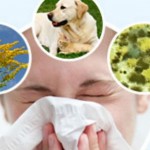Allergies
 Allergies are very common in the childhood years. To mention a few of the many factors involved – genetic tendency, pollution and smoking, toxins in food, tension (always look for signs of stress in children), marginal vitamin deficiencies and antibiotic abuse. Atopy (from the Greek for \”difference\”), the tendency to develop some form of allergic reaction, is often inherited, but the particular manifestation, including asthma, runny nose, eczema, nettle-rash (hives) and hay fever, is not necessarily hereditary.
Allergies are very common in the childhood years. To mention a few of the many factors involved – genetic tendency, pollution and smoking, toxins in food, tension (always look for signs of stress in children), marginal vitamin deficiencies and antibiotic abuse. Atopy (from the Greek for \”difference\”), the tendency to develop some form of allergic reaction, is often inherited, but the particular manifestation, including asthma, runny nose, eczema, nettle-rash (hives) and hay fever, is not necessarily hereditary.
An allergic reaction is in effect an antigen-antibody reaction. Anything that the body does not recognize as its own is seen as foreign and regarded as an antigen. The immune system produces antibodies to fight against the strange invaders The antibodies incite the white blood cells to become involved in the battle. These white blood cells, particwady the mast cells and eosinophils, secrete substances to get rid of the antigens. These substances cause changes in blood flow, muscle operation and mucous production. The body excretes the antigens through sneezing, coughing, nose-blowing, tears, perspiration, stools and breaking out in a skin rash.
The immune system produces antigens in various parts of the body to implement protection at strategic places. Cells in the mucous lining of the respiratory tract and digestive canal produce an antibody known as immunoglobulin E (IgE). Threatening antigens such as viruses and bacteria which enter the body through the airways or digestive tract activate the IgE. This leads to a cascade of inflammatory reactions to get rid of the antigens. People who suffer from allergies have an overactive antigen-antibody reaction. Even harmless substances such as house mite, pollen, animal hair or wheat set off a reaction. In such a situation the antigen is called an allergen. Allergies can develop at any stage. Some babies get atopic skin changes when they aren\’t even two months old!
The treatment of allergies includes avoiding the allergen where possible. There are also sensitisation procedures in which the patient is exposed to small amounts of the allergen at regular intervals. Over a few weeks the dose is gradually increased. This sometimes helps to prevent the allergy (especially allergies to house mite and some grasses). The immune system gradually gets used to the allergen, but it is an expensive and drawn-out process (the course can take up to two years) and children do not like injections. Antihistamines are another option. They interfere with the secretion of histamine by the mast cells in order to suppress the sneezing, congestion, itching and nettle rash. However, antihistamines can cause side effects that are often worse than the original symptoms. These include drowsiness, weakness, sluggishness, dry mouth, upset stomach and changes in the passing of stools. Expectorants, corticosteroids and nebulisers used to treat asthma also have side effects.
Conventional medicine focuses on treating the symptoms and suppressing the antigen-antibody reaction.
The more natural treatment supports the immune system and reduces the overreaction. This is done in the following ways:
- Breastfeeding: Mother\’s milk until the baby is six months old or older is excellent for the prevention of allergies.
- Good wholesome nutrition: Avoid allergens, too much sugar and preservatives. Eat fresh fruit and vegetables, fish, etc.
- Food supplements: Essential fatty acids; antioxidants such as vitamins A, C and E, selenium, zinc and copper; calcium and magnesium; methyl sulphonyl methane (100 mg a day), a natural antihistamine; medicinal herbs; local application of herbs such as calendula, aloe vera and camomile; oatmeal porridge to calm the nerves and homeopathic remedies. (Consult the relevant chapters.)
Stress management techniques: Good examples are meditation and progressive muscular relaxation. Meditation is a technique that can be used very effectively for children from the age of five until the teenage years and beyond to treat numerous psychological, allergic, concentration and self-image problems. (Consult Chapters 1, 2, 3, 9,10, 11,12, 13, 14 and 20.)
There is often confusion between the terms food allergy and food intolerance. A food allergy is an allergic reaction to certain foods, usually proteins. An immune reaction causes an abnormally high level of immunoglobulin E. A food intolerance does not involve the immune system. It involves foods that produce drug related activities in the body. Examples include reactions from tomatoes and pineapple, bacterial toxins and infections, enzyme deficiencies (such as lactose) and synthetic additives such as tartrazine and sulphites.
General food intolerances are caused by sulphites in wine or reheated vegetables (hot flushes, congestion of the respiratory tract, low blood pressure), monosodium glutamate (MSG) in Chinese food (hypertension, perspiration, vomiting, headache, increased pressure in the face), tartrazine in yellow food colouring (congestion of the respiratory tract, itching, flushed skin) and as tyramine found in matured foods such as ripened cheese (hypertension when monoamine oxidase inhibitors are used for depression).
